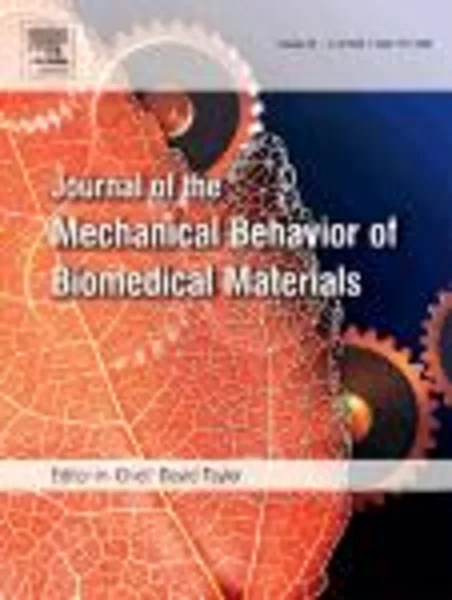-
mechanical and biodegradable properties of porous titanium filled with poly-l-lactic acid by modified in situ polymerization technique
جزئیات بیشتر مقاله- تاریخ ارائه: 1394/01/01
- تاریخ انتشار در تی پی بین: 1394/01/01
- تعداد بازدید: 739
- تعداد پرسش و پاسخ ها: 0
- شماره تماس دبیرخانه رویداد: -
porous titanium (pti) can possess a low young’s modulus equal to that of human bone, depending on its porosity. however, the mechanical strength of pti deteriorates greatly with increasing porosity. on the other hand, certain medical polymers exhibit biofunctionalities, which are not possessed intrinsically by metallic materials. therefore, a biodegradable medical polymer, poly-l-lactic acid (plla), was used to fill in the pti pores using a modified in-situ polymerization technique. the mechanical and biodegradable properties of pti filled with plla (pti/plla) as fabricated by this technique and the effects of the plla filling were evaluated in this study. the pti pores are almost completely filled with plla by the developed process (i.e., technique). the tensile strength and tensile young’s modulus of pti barely changes with the plla filling. however, the plla filling improves the compressive 0.2% proof stress of pti having any porosity and increases the compressive young’s modulus of pti having relatively high porosity. this difference between the tensile and compressive properties of pti/plla is considered to be caused by the differing resistances of plla in the pores to tensile and compressive deformations. the plla filled into the pti pores degrades during immersion in hanks’ solution at 310 k. the weight loss due to plla degradation increases with increasing immersion time. however, the rate of weight loss of pti/plla during immersion decreases with increasing immersion time. hydroxyapatite formation is observed on the surface of pti/plla after immersion for ≥8 weeks. the decrease in the weight-loss rate may be caused by weight gain due to hydroxyapatite formation and/or the decrease in contact area with hanks’ solution caused by its formation on the surface of pti/plla.
مقالات جدیدترین رویدادها
-
استفاده از تحلیل اهمیت-عملکرد در ارائه الگوی مدیریت خلاقیت سازمانی و ارائه راهکار جهت بهبود
-
بررسی تاثیر ارزش وجوه نقد مازاد بر ساختار سرمایه شرکت های پذیرفته شده در بورس اوراق بهادار تهران
-
بررسی تأثیر سطح افشای ریسک بر قرارداد بدهی شرکت های پذیرفته شده در بورس اوراق بهادار تهران
-
بررسی تأثیر رتبه بندی اعتباری مبتنی بر مدل امتیاز بازار نوظهور بر نقد شوندگی سهام با تأکید بر خصوصی سازی شرکت ها
-
تأثیر آمیخته بازاریابی پوشاک ایرانی بر تصویر ذهنی مشتری پوشاک ایرانی (هاکوپیان)
-
بررسی اثر پارامترهای سطوح مشترک بر رفتار دیوارهای حایل سنگ چین با استفاده از روش اجزا منفصل
-
اثرات کوتاه و طولانی مدت عصاره پرسیاوشان روی هموگلوبین، هماتوکریت، حجم گلبول های قرمز، زمان پروترومبین و زمان ترومبوپلاستین
-
بررسی جهش هاى نادر ژن بتاگلوبین در شمال غرب کشور
-
simulation of polycrystal deformation with grain and grain boundary effects
-
determination of mechanical properties of soft tissue scaffolds by atomic force microscopy nanoindentation
مقالات جدیدترین ژورنال ها
-
مدیریت و بررسی افسردگی دانش آموزان دختر مقطع متوسطه دوم در دروان کرونا در شهرستان دزفول
-
مدیریت و بررسی خرد سیاسی در اندیشه ی فردوسی در ادب ایران
-
واکاوی و مدیریت توصیفی قلمدان(جاکلیدی)ضریح در موزه آستان قدس رضوی
-
بررسی تاثیر خلاقیت، دانش و انگیزه کارکنان بر پیشنهادات نوآورانه کارکنان ( مورد مطالعه: هتل های 3 و 4 ستاره استان کرمان)
-
بررسی تاثیر کیفیت سیستم های اطلاعاتی بر تصمیم گیری موفق در شرکتهای تولیدی استان اصفهان (مورد مطالعه: مدیران شرکتهای تولیدی استان اصفهان)
-
نقش حسابداری مدیریت استراتژیک در عملکرد سازمانی (مطالعه موردی : هتل های 5 ستاره شهر تهران)
-
طراحی الگوی سقف شیشه ای با رویکرد نظریه داده بنیاد
-
بررسی عوامل موثر مدل سازی فرآیندهای کسب و کار(bpm) در قالب چارچوب itil جهت ارتقای هوش تجاری (bi) در سازمان تامین اجتماعی تهران
-
نقش ویژگی های کمیته حسابرسی بر رابطه بین انطباق مالیاتی و هموارسازی سود
-
بررسی ارتباط بین ضعف کنترل های داخلی و همزمانی قیمت سهام در شرکت های پذیرفته شده در بورس اوراق بهادار تهران: تبیین نقش تعدیلگر ویژگی های هیئت مدیره




سوال خود را در مورد این مقاله مطرح نمایید :